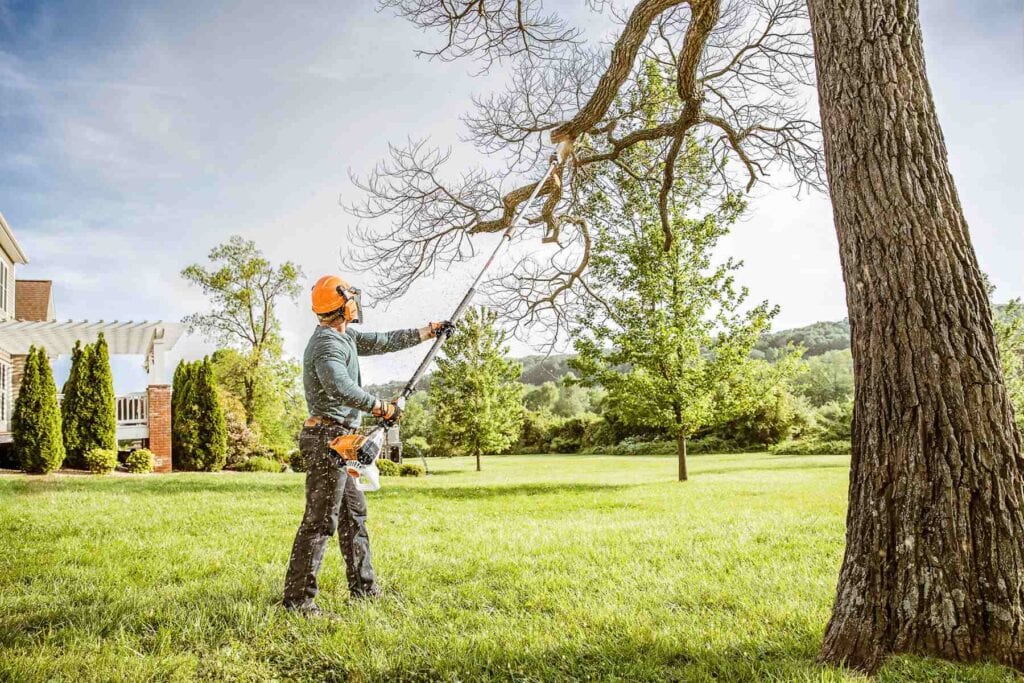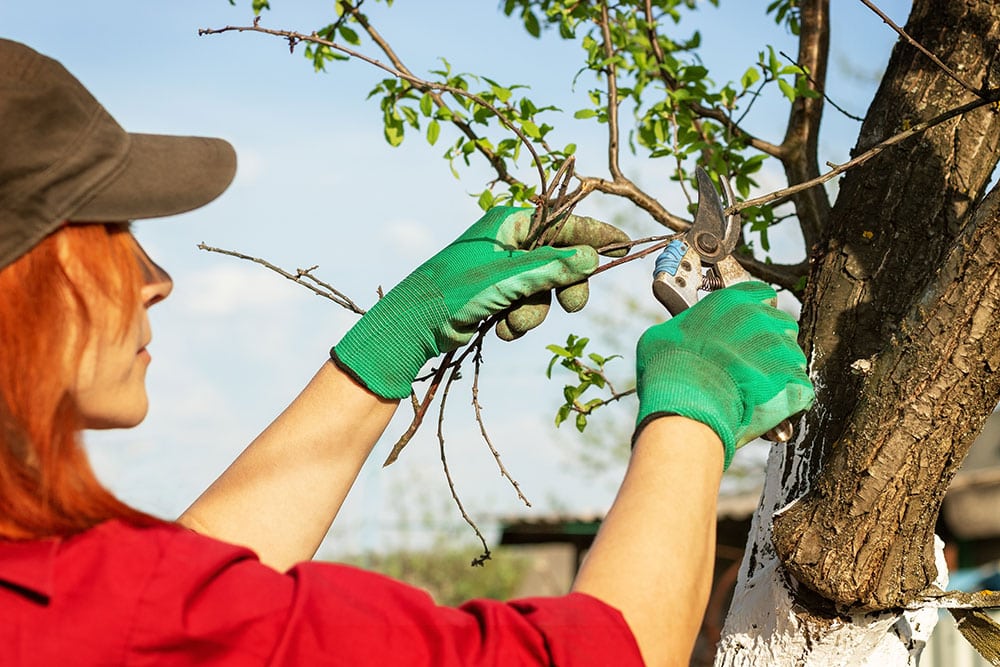You may be wondering how much trimming your tree needs. This article will discuss the appropriate amount of pruning, how often to do it, and how often is too much. It will also help you know when to stop trimming your tree altogether. If you have a large tree, you should consider having a tree professional inspect it to make sure there are no damage-causing factors.
Table of Contents
What Is the Proper Amount of Trimming Required to Maintain Tree Health?
Maintaining a tree’s health requires knowing how to trim trees correctly and safely. Prune dead or diseased branches, but avoid removing more than 25% of the canopy. Focus on shaping while preserving the natural structure to ensure stability and growth. Proper trimming promotes vitality and minimizes risks to the tree’s longevity.
How much of a tree should you trim?
It is crucial to carefully consider when and how much of a tree to trim for tree health. Generally, the rule is not to remove more than thirty percent of the live tree tissue at one time. More than that will cause internal damage to the tree and increase its risk of disease and pest infestation. If you plan to trim your tree for several years, make sure to limit the amount you remove.
Before tackling any tree trimming project, consult a professional arborist. You must keep in mind that if you are not familiar with tree pruning, it may put you at risk of injury or death. Also, you may be required to climb a ladder or trim branches near power lines. Consequently, it is much safer and more efficient to let a professional perform this task.
Regular trimming of trees is essential to ensure their health and beauty. It is best to remove dead or diseased branches and keep the remaining ones healthy. You should also prune any branches crossing each other or rubbing bark. Ideally, pruning should be done in late winter or early spring, when plants go into dormancy and prepare for new growth.
Before removing branches, you should locate the branch collar, which is the stem tissue at the base of the branch. This tissue is usually thicker than the rest of the branch. Cut the limb away from the collar at a 45-degree angle away from the trunk, as this will promote healthy callus growth.

How often should you trim your tree?
Proper pruning can help maintain tree health and prevent unhealthy branches from falling. Depending on its size and species, a tree may need to be pruned every three to five years or more. For a more precise schedule, consult an arborist or other tree care expert.
When pruning a tree, look at angles carefully and make sure to prune any branches with weak angles. Young branches are easier to prune and less likely to leave scars. It is also important not to trim too closely or leave a huge stub. Make sure to follow the rules for pruning a tree based on its age.
Trees differ greatly in their size and shape, and some grow quickly, while others grow slowly. Your tree’s growth rate will depend on the climate and weather conditions, as well as its health. If it is not pruned properly, it may become diseased and unattractive. For these reasons, the best time to prune your tree is on a regular schedule.
Trimming weak limbs is important to ensure the overall health of your tree. It will reduce the risk of falling limbs, and will encourage healthy new growth. Remember to also trim branches near utility lines. In some cases, this is a requirement to protect your property from damage.
Can you trim too much of a tree?
Pruning your tree is an essential part of tree care. But it’s important not to overdo it! Generally speaking, trees should be pruned once a year during their dormancy. This reduces the stress on the tree and encourages new growth. Trimming a tree during dormancy also prevents fungus and insects from settling into the cut.

How do I know if my tree needs trimming?
There are some signs that you should consider before deciding whether your tree needs trimming. Deadwood, for example, can be an indication of a decaying or pest infestation. If you see deadwood in your tree, you should get it trimmed to prevent spreading disease and decay to the rest of your tree. If you see branches growing too close to power lines, it’s probably time to call a professional.
In addition to curb appeal, a properly trimmed tree will add to the beauty of your yard. It will also prevent property damage from falling limbs. Cracks may also indicate that your tree needs pruning. Cracks will cause rot to set in quickly. It’s best to get in contact with a tree expert as soon as you notice these symptoms. The sooner you can make the necessary repairs, the better.
Another sign that your tree needs pruning is a branch that is too dense. These types of branches are more likely to break and can cause damage to your property if they get too thick. When it’s time for trimming, make sure to measure the thickness of the branches on your tree. If they’re too thick, you’ll have to prune them and risk damaging the tree permanently.
Generally speaking, a tree should never grow too large for an owner to control. Trimming should only be done when aesthetic and safety concerns are present. Never prune a tree if you’re unsure whether it’s healthy or not.

What month is best to trim trees?
Trees need to be pruned at certain times of the year, and the wrong month can make them vulnerable to disease and insects. For example, oak wilt can spread through the entangled roots of an oak tree, so you should avoid pruning oak trees during the summer months. However, if you are concerned about a tree’s health, consider pruning it in the late fall or early winter.
Deciduous trees need pruning in winter and early spring. But some unwanted branches only grow during the summer, including vertical waterspouts. During summer, you can trim a fruit tree, though be careful not to over-prune as it may weaken the tree.
Tree health depends on the species of the tree and the results you want to achieve. For example, you may want to prune your spruce during the dormant season, which is between late fall and early spring. This time will allow for better visibility and proper wound closure. In addition, you will also minimize the risk of disease or pest infestation.
Whether you’re pruning fruit trees or flowering trees, you need to consider the climate in your area. Early pruning can harm new growth and stunt blooming. Also, you don’t want to prune your trees in the spring, because they’ll suffer from leaf burn in the fall.
What happens if you cut all the branches off a tre
Cutting off all the branches from a tree isn’t always the best idea. It can be harmful to the tree, but cutting off dead branches helps it stay healthy. Without branches, the tree will not grow properly and its structure will suffer. It’s better to remove the dead branches from your tree every two to three years.
In order to prevent a tree from dying, you should only cut off as many branches as needed. It’s best to leave about fifty percent of the crown intact. Otherwise, the tree will not produce enough foliage to survive. Additionally, a bigger wound won’t heal quickly, leaving the tree susceptible to disease and pests.
Another common mistake is over-pruning trees. This is one of the most damaging things you can do to a tree. Many novices make this mistake, and it can actually lead to weak, weakened branches. Cut branches too close to the ground and you will end up with weak branches that can break off and fall during heavy winds or storms.
The first step in pruning a tree is to find the branch collar. The collar is a thicker area that surrounds the branch’s base. Avoid cutting outside of the collar as this will cause damage to the branch, and it will cause the bark to split.